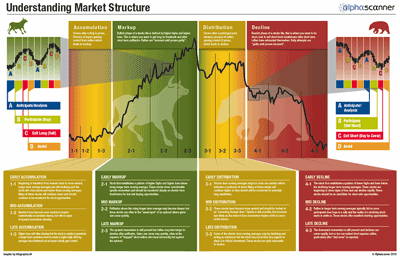Technical analysis gets a lot of criticism from people who do not fully appreciate the level of simplicity that chart analysis works best. I believe that terms like: Hindenburg Omen, Death Cross, Golden Cross, Fibonacci, Adams Pitchfork, Lunar Cycles, etc., are largely a distraction to the true value of technical analysis: simple recognition of trend, timing, and risk management. I would never say that some of those indicators are worthless, but there is only one thing that pays us or punishes us in the market and that is price action, only price pays! So doesn’t it stand to reason that we should focus our attention on price action? That is what this chapter is about, if you are looking for any "new science in technical analysis" or a cleverly named pattern, flip to another chapter. If you are interested in how to utilize stock charts to find low risk/ high potential trade ideas and manage risk, let's get started.
Many people mistakenly use technical analysis as a system: buying moving average crossovers, or when an indicator flashes "oversold." Technical analysis should be used as a framework to form our analysis, which starts with simple understanding of market structure. When we analyze the market based on listening to its message, we can assess probabilities of success and risk objectively and plan our trades without the damaging influence of emotions. Many experts will tell you to "control your emotions" which is obviously easier said than done. It is easier to have a plan of action laid out in advance to minimize the chances of emotions coming into the decision making process.
Beginning with the "Four Stages" of a stocks life cycle, we know that stocks are either advancing, declining or in a neutral period. Cyclical analysis recognizes there are four stages: Stage 1—Accumulation, Stage 2—Mark-up, Stage 3—Distribution, and Stage 4—Decline. Putting labels on the stages of the lifecycle allows us to not only easily recognize and scan for opportunities, but also to recognize times of uncertainty so we can step aside and have the safety of cash as a position. Generally speaking, trend traders want to be long stocks in Stage 2, short in Stage 4, and to avoid the neutral Stage 1 and 3 periods. See the chart above for further detail.
Trading and investing sounds easy with phrases like "the trend is your friend," just buy a stock in an uptrend and sell when it stops going up, right? The problem is that there can be several trends present which send conflicting messages. The longer-term may be in a solid uptrend, but short-term, the stock may be experiencing a normal, but brutal, bout of profit taking. These pullbacks can be the beginning of the end, or they may just be the pause which refreshes before the stock is able to continue on to new highs. The fact is, at the time the stock is undergoing short-term profit taking, the uncertainty can be high and if you buy the stock just as it begins to correct, you can experience large losses in the short-term while still be correct about the longer-term trend. If your timing is off, you may be stopped out of what might have been a good trade. In order to stack the odds of success greater in your favor, analysis of multiple timeframes will allow you to make much better decisions on the timing of your entries, which puts you in a position of strength right from the beginning of your trade.
When we analyze a stock with charts, we should use a minimum of three different timeframes. Just as Charles Dow recognized three different trends, we should start with that as a minimum. For this example, we will consider the goal of finding a good swing trade candidate. To start our analysis, we should begin with a longer-term timeframe, in this case that will be a chart with daily candles which shows approximately one-year of data. Using just price, volume and a 50-day moving average (DMA), we should be observing what the primary trend is. A very quick way to sum up the trend here is to observe the location of the stock in relation to the 50-DMA and what the slope of that moving average is. Generally, we will consider the stock "innocent until proven guilty" if it has a pattern of higher highs and higher lows above a rising 50-DMA and "guilty until proven innocent" if it shows lower highs and lower lows below a declining 50-DMA. When observing volume, we want to see a pattern of expanding volume in the direction of the trend followed by lighter volume as volatility contracts and short-term corrections ensue. Assuming that we are looking for a long side trade, we will start with a stock in an uptrend and then drill down our analysis to a shorter-term timeframe.
The intermediate-term timeframe a swingtrader will want to consider is a chart constructed with 65- or 30-minute candles, we will generally observe 20-30 days for this timeframe. 65- and 30-minute timeframes are ideal here because they allow us to look at the data without being "scrunched up" if we were using a shorter-term timeframe for this many days. It is also important to be sure that we have the data presented with an equal number of candles for each day. If we were using 60-minute candles, there would be six candles with 60 minutes of data and one candle with 30 minutes of trading data, this is similar to comparing six apples to one orange. With 390 minutes in a trading day, it is more accurate to observe six equal periods of 65-minute data or 13 periods of 30-minute data. I think the absolute best moving average (MA) to use on this timeframe is a 5-day MA. Be careful not to enter a 5-"period" MA, because it will follow right on top of the candles and will not provide a useful reference point. In order to look at a 5-day MA, we need to consider some simple math. Each day the market is open for 13 individual 30-minute periods, over five days, there are 65 to 30-minute periods, so if we place a 65-period MA on the 30-minute timeframe, we are looking at a dynamic 5-day moving average price of the stock. For a 65-minute chart, the 5-day MA is represented with a 30-period MA. Long trades should typically be entered as the stock is above a 5-DMA which is just starting to slope upward and is acting as support. Short sales should be placed as the stock is under a 5-DMA which is just beginning to decline and act as resistance.
What we want to observe on the intermediate-term timeframe is where the stock is in relation to the 5-DMA, the slope of the 5-DMA and where the important support and resistance levels reside. This is the time to ask two questions. One, where has the stock come from? Meaning has it rallied the last three days and is now "extended" from an important level of support? If so, we may be late to the movement and the chances of a correction (by price or through time) may be too great to justify taking a position. If instead, the stock has experienced a short-term pullback and has found support, it is likely a great stock to stalk for strength with a stop just below the consolidation area. This is how we determine the potential for price risk and stop placement on the trade. The second question we want to answer on this timeframe is, "Where does the stock have the potential to go?" Put simply, does it appear that there will be enough profit potential relative to the risk we have perceived? If the stock appears to have a prior important level of resistance just above where it is trading, the potential for profit may not justify taking an actual trade. The answers to these two questions allow us to determine our "risk/reward". A commonly accepted risk/reward ratio is 1:3 meaning that you would be willing to risk one dollar to make three dollars. A ratio like this means you could lose on two trades and still come out ahead if you made three dollars on a third trade, trading isn't about being right all the time, it is about managing risk so you can consistently come out ahead.
Short-term analysis can be taken as deep as you like, but there is the danger that if you look too closely, you will "lose sight of the forest by focusing on the trees." In other words, the shorter the timeframes you look at, the greater the likelihood of micromanaging the trade becomes and you lose out on the bigger profit opportunities observed on the intermediate-term timeframe. We will continue with our swing trade example and use either a 5- or 10-minute timeframe (I like to switch between the two for more clarity, it is a way to avoid the "compression" of data) to get a closer look at the action. A look at shorter-term trends gives us clues for when to not only enter the trade, but to manage a trade over the course of 2-5-10 or days. Just as we observe the four stages on a longer-term timeframe, the shorter-term timeframes allow us to clearly see market structure.
For a bullish example, we will look at 15 days worth of 10-minute data to see the four stages repeated within the longer bullish Stage 2 action. When looking at the data for approxiately 15 days, we can see shorter-term cycles, and here is how we want to approach these trends with the goal of entering a stock as the trend becomes aligned. If we have bullish daily chart, the action of a swing trader should be dictated by where the stock is in the shorter-term cycle.
When we have a longer-term Stage 2 Mark-up and shorter-term trend is:
- Stage 1—Accumulation—This is where we do our planning, we observe, analyze, and ANTICIAPTE the point where buyers will take control and think of our price objectives and stop levels.
- Stage 2—Mark-up—As the stock makes a short-term higher high, we want to buy the stock; we want to PARTICIPATE in what appears to be a developing trend. Stage 2 is also where we manage our winners by raising the stop up under higher lows.
- Stage 3—Distribution—The stock is now showing signs of fatigue and may be in need of a "correction through time," this is a good point to EXIT the position or to lock in at least partial profits.
- Stage 4—Decline—When the primary trend is higher, this is likely just a pullback and the odds do not favor profitable short sales, it is better to AVOID these stocks and look for better set-ups where trends are coming into alignment.
When we have a longer-term Stage 4 DECLINE and shorter-term trend is:
- Stage 3—Distribution—This is where we do our planning, we observe, analyze, and ANTICIAPTE the point where sellers will take control and think of our price objectives and stop levels.
- Stage 4—Decline—As the stock makes a short-term lower low, we want to enter our short position, and we want to PARTICIPATE in what appears to be a developing trend. Stage 4 is also where we manage our winners by lowering the stops up above the lower highs.
- Stage 1—Accumulation—The sellers are now showing signs of fatigue and the stock may be in need of a "correction through time," this is a good point to EXIT the position or to lock in at least partial profits.
- Stage 2—Mark-up—When the primary trend is lower, this is likely just a short-term bout of strength and the odds do not favor profitable long trades. It is better to AVOID these stocks and look for better set-ups where trends are coming into alignment.






















